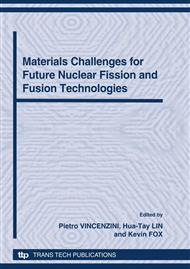p.97
p.104
p.109
p.118
p.124
p.130
p.136
p.142
p.148
The Influence of Helium and ODS on the Irradiation-Induced Hardening of Eurofer97 at 300°C
Abstract:
The influence of helium on the mechanical properties of reduced-activation ferritic/martensitic Cr-steels under fusion-relevant irradiation conditions is still a concern. While the fact that He can influence the mechanical properties is well established [1,2], the underlying mechanisms are not fully understood [1,2]. In this work the effect of He and displacements per atom (dpa) on the irradiation-induced hardening of Eurofer97 at 300°C was studied. Self-ion irradiation was applied to simulate the neutron-irradiation-induced damage. Helium was implanted prior to (pre-implantation), simultaneously (dual-beam irradiation) or following the (post-implantation) self-ion irradiation to investigate the He effect. Nanoindentation was used in order to characterize the damage layer. Under the present conditions (300°C, 1 dpa, 10 appmHe) the observed hardening increased in the following order: single-beam Fe-ion irradiation/pre-implantation < simultaneous implantation < post-implantation. We conclude, that there is a significant interaction between damage and He. Additionally, Eurofer97 and ODS-Eurofer were irradiated with Fe ions up to 1 and 10 dpa to study the effect of the oxide particles on the irradiation-induced hardening. We have found a higher irradiation-induced hardening at 1 dpa for ODS-Eurofer but a steeper hardness increase per dpa up to 10 dpa for Eurofer97.
Info:
Periodical:
Pages:
124-129
Citation:
Online since:
October 2010
Authors:
Keywords:
Price:
Сopyright:
© 2010 Trans Tech Publications Ltd. All Rights Reserved
Share:
Citation:


